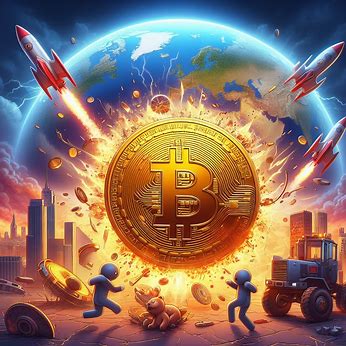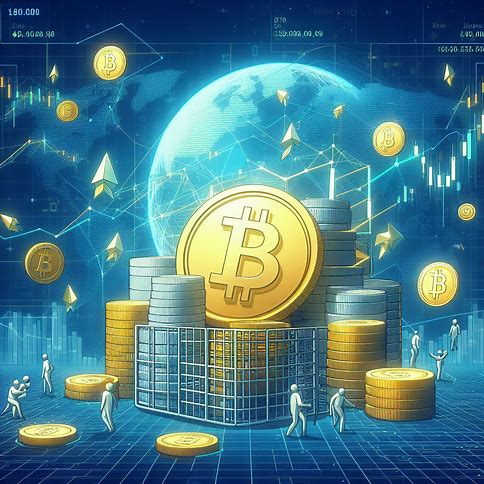Cryptocurrency prices can be an extreme in some ways – one minute they’re soaring to new heights, the next they’re crashing back down to earth. But what’s really causing these fluctuations? Believe it or not, geopolitical events happening around the world can have a huge impact. Here are some of the impact of geopolitical events on cryptocurrency prices.
1. How Global Events Move Crypto Markets
Cryptocurrencies like Bitcoin and Ethereum have gained mainstream attention, as a new asset class and potential investment opportunity. However, crypto prices are notoriously strained and can see dramatic swings up or down in relatively short periods of time.
While some of this volatility is driven by speculation, hype cycles, and the early-stage nature of the crypto market, geopolitical events and shifts in the global economy can also have a profound impact on cryptocurrency prices. Here are a few key ways that geopolitics intersects with crypto:
1. Political Instability and Economic Turmoil
In times of political upheaval, economic crisis, or soaring inflation in a particular country or region, cryptocurrencies can be seen as a “safe haven” asset since they are decentralized and not tied to any government or fiat currency. For example, crypto trading volumes surged in Venezuela as hyperinflation plagued the Venezuelan bolivar.
Similarly, economic turmoil and the US-China trade war in 2019 coincided with a major Bitcoin bull run, as some investors flocked to crypto amidst the uncertainty. Political instability and lack of faith in governments can drive people towards the decentralized nature of cryptocurrencies.
Related: Bitcoin Ordinals VS. Ethereum NFTs: A Comparative Overview
2. Capital Controls and Regulations
Governments and central banks implementing stricter capital controls, regulations, or outright bans on cryptocurrencies can have a chilling effect on crypto markets and prices. For instance, when China announced a crackdown on crypto trading and mining in 2021, it triggered a steep sell-off and sent Bitcoin and other crypto prices plummeting.
On the flip side, countries taking a more open, progressive stance towards crypto, like El Salvador making Bitcoin legal tender, can boost enthusiasm and crypto prices. Regulatory clarity, or lack thereof, from major governments remains one of the biggest sources of uncertainty overhanging crypto markets.
3. Macroeconomic Factors and Monetary Policy
Cryptocurrencies don’t exist in a vacuum – they are part of the broader global financial system. As such, major macroeconomic factors like interest rates, inflation, economic growth, and monetary policy can all spillover and impact crypto asset prices.
For example, when the US Federal Reserve and other central banks around the world pursued unprecedented quantitative easing and low interest rates in the wake of the COVID-19 crisis, it flooded markets with liquidity and devalued fiat currencies. This easy monetary policy was one factor driving crypto prices to new heights in 2020-2021, as investors sought returns and a hedge against inflation.
Conversely, when central banks start to tighten monetary policy and raise interest rates to combat inflation, as we saw in 2022, it can suck liquidity out of speculative assets like cryptocurrencies and cause prices to tumble. The global macroeconomic environment plays a significant role in setting the overall tone for risk appetite and crypto market sentiment.
4. Geopolitical Tensions and Conflict
Escalating geopolitical tensions, armed conflicts, and other major international incidents often lead to turbulence across global financial markets – and crypto markets are no exception. A prime example is Russia’s invasion of Ukraine in early 2022.
The outbreak of war in Europe sent shockwaves through markets and initially caused a sharp decline in crypto prices. However, in the following weeks cryptocurrency donations poured in to support Ukraine, and demand for crypto surged in Russia as a way to evade international sanctions, causing prices to rebound. Geopolitical flare-ups can whipsaw crypto prices as uncertainty spikes.
5. Adoption by Governments and Institutions
On the other end of the spectrum from conflict and crackdowns, the increasing adoption and acceptance of cryptocurrencies by governments, major companies and financial institutions acts as a positive driver for crypto prices.
News like Tesla buying $1.5 billion worth of Bitcoin and accepting it as payment, or major investment banks like Goldman Sachs and JPMorgan launching crypto trading desks, lends greater credibility and mainstream acceptance to the asset class. Integrating crypto into the traditional financial infrastructure helps boost sentiment and prices.
2. Crypto Prices and the Global News Cycle
These days, cryptocurrency markets react in real time to major global news events. Bullish or bearish headlines can trigger significant price movements:
- Elon Musk tweets about Dogecoin? The memecoin’s price goes soaring.
- China FUD (fear, uncertainty, doubt) about banning Bitcoin? Cue the crypto market sell-off.
- The latest US inflation figures come in hotter than expected? Watch Bitcoin’s price action closely.
Cryptocurrency investing and trading is a 24/7, 365 days-a-year market that never sleeps. Staying on top of the latest geopolitical events and macro developments has become essential for crypto traders looking to manage risk and capitalize on volatility.
At the same time, it’s important to zoom out and keep the long-term outlook in perspective. While geopolitical events can trigger short-term price turbulence, the value proposition and fundamentals of cryptocurrencies like Bitcoin – digital scarcity, decentralization, a hedge against fiat debasement – remain intact through news cycles.
Key Takeaways
1. Cryptocurrency prices are highly volatile and can be significantly impacted by geopolitical events and global economic developments.
2. Political instability, economic turmoil, and lack of faith in governments can drive adoption of cryptocurrencies as a “safe haven” outside the traditional financial system.
3. Government regulations, capital controls, and crackdowns on cryptocurrencies can have a chilling effect on crypto markets and prices.
4. Macroeconomic factors like interest rates, inflation, economic growth, and monetary policy can spillover and impact crypto asset prices.
5. Geopolitical tensions, armed conflicts, and major international incidents can whipsaw crypto prices as uncertainty spikes.
6. Increasing adoption and integration of cryptocurrencies by governments, major companies and financial institutions helps boost crypto market sentiment and prices.
7. Crypto markets react in real-time to major global news events and headlines in today’s interconnected digital time.
8. The impact of geopolitical events on crypto prices highlights the growing integration and correlation of digital assets with traditional financial markets and the global economy.
9. The role of cryptocurrencies in geopolitics and the global financial system is still evolving, with major questions around regulation, central bank digital currencies, and nation-state adoption.
10. As cryptocurrencies mature, they become more sensitive to the same macro forces that drive other asset classes, but the long-term outlook remains focused on their fundamentals and value proposition.
Frequently Asked Questions
1 What are some examples of geopolitical events that have impacted crypto prices?
Some notable geopolitical events that have moved crypto markets include:
- China’s crackdown on crypto trading and mining in 2021, which triggered a steep sell-off
- Russia’s invasion of Ukraine in 2022, which caused volatility and a surge in crypto adoption in both countries
- The US-China trade war and economic turmoil in 2019, which coincided with a Bitcoin bull run
- Venezuela’s economic crisis and hyperinflation, which drove citizens to crypto as a safe haven
2. How do macroeconomic factors like interest rates affect cryptocurrencies?
Macroeconomic factors can significantly impact the overall financial market sentiment and risk appetite, which spills over into crypto markets. For example:
- Low interest rates and quantitative easing can devalue fiat currencies and drive investors to seek returns in speculative assets like crypto
- Rising interest rates and tighter monetary policy can suck liquidity out of risk assets and dampen enthusiasm for cryptocurrencies
- High inflation can make fixed-supply cryptocurrencies like Bitcoin more attractive as a potential hedge against currency debasement
3. Why do cryptocurrencies tend to be more volatile than other asset classes?
Cryptocurrencies are a young, emerging asset class that is still evolving, which contributes to higher volatility compared to more established markets. Some reasons include:
- The crypto market is relatively small and illiquid compared to traditional asset markets, so large trades can move prices more easily
- Crypto trading happens 24/7 and reacts in real-time to news and speculation, whereas stock markets have set trading hours and “cool off” periods
- There is a lot of uncertainty and speculation around the future adoption, regulation, and legal status of cryptocurrencies
- The crypto space is rife with hype cycles, narratives, and “fear of missing out” that can amplify price swings
4. Can geopolitical events be an opportunity for crypto investors?
Geopolitical events can create significant volatility and uncertainty in crypto markets, which brings both risks and opportunities for savvy investors. Some strategies include:
- “Buying the dip” during geopolitical-induced sell-offs with the expectation that prices will eventually recover
- Using stablecoins or less volatile crypto assets as a temporary safe haven during periods of market turmoil
- Monitoring geopolitical developments to anticipate and position for potential market moves or shifts in sentiment
- Maintaining a long-term perspective and staying invested in fundamentally sound projects through short-term news cycles.










